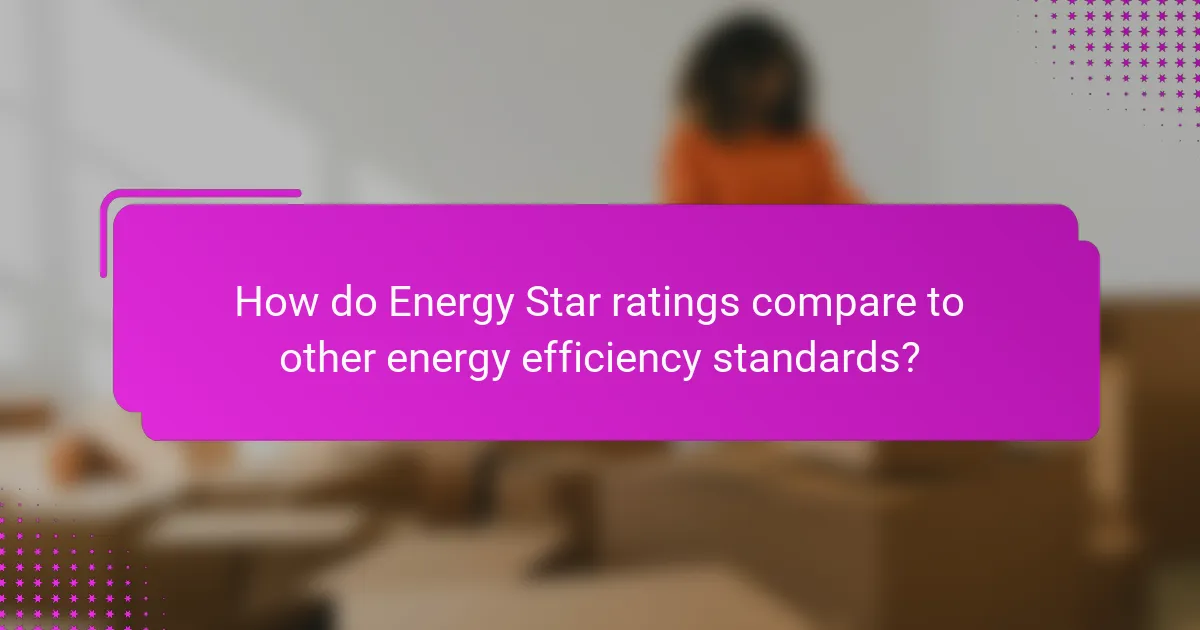Energy Star ratings serve as a reliable certification system that identifies energy-efficient products and buildings, ensuring they meet stringent performance standards established by the U.S. Environmental Protection Agency (EPA) and the U.S. Department of Energy (DOE). By choosing Energy Star certified items, consumers can enjoy lower utility bills and improved comfort while contributing to environmental sustainability.

What are Energy Star ratings?
Energy Star ratings are a certification system that identifies energy-efficient products and buildings. These ratings help consumers make informed choices by highlighting items that meet strict energy performance standards set by the U.S. Environmental Protection Agency (EPA) and the U.S. Department of Energy (DOE).
Definition of Energy Star ratings
Energy Star ratings signify that a product or building meets energy efficiency guidelines established by the EPA. This certification is applicable to a wide range of products, including appliances, electronics, and homes, indicating that they use less energy compared to standard models.
Products with the Energy Star label typically consume 10-50% less energy than their non-certified counterparts, contributing to lower utility bills and reduced greenhouse gas emissions.
History of Energy Star program
The Energy Star program was launched in 1992 as a voluntary labeling initiative aimed at promoting energy efficiency. Initially focused on appliances, it has expanded to cover various sectors, including commercial buildings and residential homes.
Over the years, the program has evolved to include more stringent criteria and a wider array of products, reflecting advancements in technology and growing awareness of environmental issues.
Entities involved in Energy Star certification
The Energy Star certification process involves several key entities, primarily the EPA and DOE, which set the standards and guidelines for certification. Additionally, manufacturers and service providers play a crucial role by designing products that meet these standards and submitting them for evaluation.
Independent testing laboratories and certification bodies are also involved, ensuring that products are rigorously tested and verified before receiving the Energy Star label. This collaborative approach helps maintain the integrity and reliability of the Energy Star program.

How do Energy Star ratings benefit consumers?
Energy Star ratings provide consumers with assurance that products and homes meet energy efficiency standards, leading to lower utility bills and enhanced comfort. These ratings help buyers make informed choices that not only save money but also contribute to environmental sustainability.
Energy savings
Energy Star-rated products are designed to use less energy than their non-rated counterparts, resulting in significant savings on electricity bills. For instance, Energy Star appliances can be 10-50% more efficient, depending on the product category.
When purchasing an Energy Star home, homeowners can expect lower monthly utility costs. This efficiency translates to savings that can amount to hundreds of dollars annually, depending on local energy prices and usage patterns.
Environmental impact
Using Energy Star-rated products helps reduce greenhouse gas emissions, contributing positively to the environment. For every Energy Star product sold, there is a reduction in carbon dioxide emissions, which is crucial in combating climate change.
By choosing energy-efficient options, consumers play a role in conserving natural resources. This collective effort can lead to a significant decrease in energy consumption at a national level, promoting a more sustainable future.
Increased property value
Homes with Energy Star ratings often have higher resale values compared to similar properties without such certifications. Buyers are increasingly looking for energy-efficient homes, making these properties more attractive in the real estate market.
Investing in Energy Star upgrades can yield returns on investment, sometimes recouping costs through increased property value and reduced operating expenses. This trend is particularly relevant in areas where energy efficiency is prioritized by local regulations or buyer preferences.

How can businesses achieve Energy Star compliance?
Businesses can achieve Energy Star compliance by following specific guidelines set by the Environmental Protection Agency (EPA) to enhance energy efficiency in their operations. This involves assessing energy performance, implementing improvements, and submitting necessary documentation for certification.
Steps to obtain Energy Star certification
To obtain Energy Star certification, businesses should start by conducting an energy audit to identify areas for improvement. Next, they should implement energy-saving measures, which may include upgrading equipment, optimizing processes, or enhancing building insulation. Finally, businesses must submit their energy performance data to the EPA for evaluation.
Required documentation for compliance
Documentation for Energy Star compliance typically includes energy performance metrics, details of energy-saving measures implemented, and a completed application form. Businesses may also need to provide utility bills and other relevant records to demonstrate energy usage over a specified period. Ensuring all documentation is accurate and complete is crucial for a smooth certification process.
Common challenges in achieving compliance
One common challenge businesses face in achieving Energy Star compliance is the initial cost of implementing energy-efficient upgrades. Additionally, organizations may struggle with accurately measuring and reporting energy performance, especially if they lack the necessary tools or expertise. To overcome these obstacles, businesses should consider seeking assistance from energy consultants or leveraging available financial incentives.

What are the costs associated with Energy Star certification?
The costs associated with Energy Star certification can vary significantly based on the type of product or building being certified. Key expenses include certification fees, costs for energy-efficient upgrades, and the potential return on investment from these improvements.
Certification fees
Certification fees for Energy Star can range from a few hundred to several thousand dollars, depending on the complexity of the application and the type of product or building. For example, residential buildings may incur lower fees compared to commercial properties. It’s essential to check with the specific certification body for precise fee structures.
In addition to the initial certification fee, there may be annual renewal fees or costs for re-evaluations, which can add to the overall expense. Budgeting for these ongoing costs is crucial for maintaining Energy Star status.
Cost of energy-efficient upgrades
Investing in energy-efficient upgrades is often necessary to meet Energy Star standards. These upgrades can include improved insulation, energy-efficient windows, HVAC systems, and appliances. The costs for these improvements can range from a few thousand to tens of thousands of dollars, depending on the scope of the project.
Homeowners and businesses should consider the long-term savings on energy bills when evaluating these costs. Many upgrades can lead to significant reductions in energy consumption, which may offset the initial investment over time.
Return on investment analysis
Conducting a return on investment (ROI) analysis is crucial before pursuing Energy Star certification. This analysis should factor in the costs of certification and upgrades against the expected energy savings and potential increases in property value. Generally, properties with Energy Star certification can see a higher resale value and lower operating costs.
To perform an effective ROI analysis, consider using tools or calculators that estimate energy savings based on local utility rates and the specific upgrades being made. This can provide a clearer picture of the financial benefits associated with Energy Star certification.

What are the local Energy Star initiatives in the United States?
Local Energy Star initiatives in the United States focus on promoting energy efficiency through various programs and incentives tailored to specific states and communities. These initiatives aim to reduce energy consumption, lower utility bills, and minimize environmental impact by encouraging the adoption of Energy Star-rated products and practices.
State-specific programs
Each state in the U.S. may have its own Energy Star programs designed to meet local energy needs and regulations. For instance, California has the California Energy Commission, which promotes energy efficiency through rebates and incentives for Energy Star appliances. Similarly, New York offers programs that provide financial assistance for upgrading to Energy Star-certified products.
These state-specific initiatives often include energy audits, financial incentives, and educational resources to help residents understand the benefits of energy-efficient products. It’s essential to check with local energy providers or state energy offices for details on available programs.
Local incentives for Energy Star products
Many local governments and utility companies offer incentives to encourage the purchase of Energy Star products. These incentives can include rebates, tax credits, or financing options that make energy-efficient appliances more affordable. For example, some utilities may provide cash rebates for purchasing Energy Star refrigerators or washing machines.
To maximize savings, consumers should research available local incentives before making a purchase. Websites like Energy Star’s official site can help identify specific programs in your area, ensuring you take full advantage of the financial benefits associated with energy-efficient choices.

How do Energy Star ratings compare to other energy efficiency standards?
Energy Star ratings are a widely recognized benchmark for energy efficiency, primarily focusing on appliances and buildings. Compared to other standards, Energy Star emphasizes consumer products and operational efficiency, while other certifications may cover broader environmental impacts or specific building practices.
Comparison with LEED certification
LEED (Leadership in Energy and Environmental Design) certification is a comprehensive green building rating system that evaluates a building’s environmental performance across various categories, including energy efficiency, water usage, and indoor environmental quality. While Energy Star focuses primarily on energy performance, LEED encompasses a wider range of sustainability factors.
For instance, a building can achieve Energy Star certification by meeting specific energy performance criteria, but to earn LEED certification, it must score points across multiple sustainability categories. This means that a LEED-certified building may have a higher overall environmental impact than a building with only Energy Star certification.
Comparison with HERS ratings
The Home Energy Rating System (HERS) provides a score that reflects a home’s energy efficiency based on a comprehensive evaluation of its energy use. Unlike Energy Star, which certifies products and buildings that meet certain energy efficiency thresholds, HERS scores are numerical and can range from 0 to over 150, with lower scores indicating better energy performance.
For example, a home with a HERS score of 60 is considered 40% more energy-efficient than a standard new home. While both Energy Star and HERS ratings aim to promote energy efficiency, HERS provides a more detailed assessment of a home’s energy performance, which can help homeowners identify specific areas for improvement.

What are emerging trends in energy efficiency ratings?
Emerging trends in energy efficiency ratings focus on integrating advanced technologies and innovative practices to enhance energy performance. These trends aim to improve sustainability, reduce costs, and comply with evolving regulations.
Advancements in smart technology
Smart technology is revolutionizing energy efficiency ratings by enabling real-time monitoring and automation of energy consumption. Devices such as smart thermostats and energy management systems allow users to optimize their energy use based on actual needs, leading to significant savings.
For example, smart thermostats can learn user habits and adjust heating and cooling accordingly, potentially reducing energy consumption by 10-15%. Additionally, integrating smart appliances with energy efficiency ratings can provide insights into usage patterns, helping consumers make informed decisions.
When considering smart technology, ensure compatibility with existing systems and check for any additional costs associated with installation and maintenance. Prioritize devices that are certified by recognized energy efficiency programs to guarantee performance and reliability.


